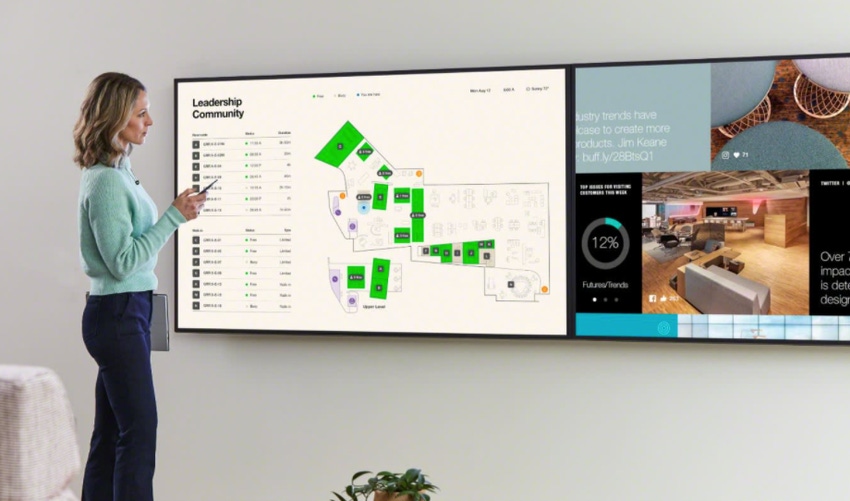Technology can help companies plan for a more hands-free return to the workplace.
June 15, 2020

Sponsored by Steelcase Roam
Let’s face it–our hands are germ-spreading machines. We’ve heard over and over again since the onset of the coronavirus that the best way to stop the transmission is to wash our hands. We’ve been told to stop touching our face and avoid shaking hands. So, as some organizations begin to return to the workplace, there’s a logical focus on changing behaviors to avoid unnecessary contact. The good news is that technology already exists to create a more hands-free workplace.
Careful and responsible choices about employees’ return to the workplace make safety paramount. People need to be safe and feel safe. That means not only putting infection control measures in place, but also reinforcing new protocols and processes with better tools and persistent visual cues. These are areas where technology is already ahead of us. Here’s how:
Touchless Reservations
Reserving a space in the office can mean walking around until you find what’s available and then touching an on-demand device to secure the room’s use. There are two problems with this in a post-COVID world: We no longer want to be wandering around aimlessly searching for space and passing lots of other people while we do it, and we don’t want to touch devices others have used unless they’ve been cleaned first.
Engineers and designers were thinking about ease of use when they designed Auto Book and Auto Release. These features integrate Workplace Advisor Subscription sensor data with RoomWizard, a room reservation system. Now, Auto Book and Auto Release are in place to add more safety to the office environment by automating the booking experience when someone walks into a space or doesn’t show up at all. The room knows when it’s occupied and when it’s empty, and can automatically book the space or release it without anyone having to touch a thing.
Visible from a Distance
Many organizations are considering adopting new circulation patterns upon a return to the workplace. They’ll be asking people to walk their space in one direction to avoid bumping into others and eliminate close encounters in hallways.
So, while it used to simply be an annoyance when room signage was hard to see, now being able to see at a distance if a room is occupied can help create a safer environment. Designers who created the recently released, next-generation RoomWizard equipped its digital signage with a bold interface that displays critical meeting information that’s easy to read at a distance. Clear, simplified digital signage can help avoid unnecessary hovering outside of a room and prevent people from having to traipse across the office floor just to see how long a space will be in use. In addition, these visual reinforcements can help accelerate behavior changes. For example, use RoomWizard to book spaces twice a day for cleaning and reinforce the need to clean between uses.
Book Space with Your Phone
Before the coronavirus, most of us didn’t think twice about using the on-demand reservation feature on our room reservation system. But now, touching a device so many others have touched doesn’t sound very appealing. No need to worry–there’s an app for that. Steelcase Find connects to Workplace Advisor and Microsoft Office 365 to let employees use their smartphones to select space requirements, see what’s available, reserve a room and share it with colleagues. Those reservations are reflected in Office 365 and on RoomWizard digital displays.
Visual Cues about Density
Many organizations are planning a phased approach as they seek to return people safely to the workplace. They may start with 50% occupancy and increase that over time. Yet, regardless of how many people are in the office, there’s a tremendous benefit to understanding which areas are “hot spots” for activity and helping people find less-populated spaces to work in each day.
Steelcase Live Map lets people easily check a user-friendly display as soon as they enter the office. Like the Find app, it pulls scheduling data from Microsoft Office 365 and occupancy data from Workplace Advisor sensors to show real-time availability of rooms, desks and workspaces. Employees can see density at-a-glance and head to a space that’s occupied by fewer people.
Voice-Activated Collaboration
As people head back to the workplace, they will likely still have colleagues working from home and travel will continue to be reduced. Large-scale collaboration devices like the Microsoft Surface Hub 2 are designed and engineered to improve the experience of working together even when you’re physically apart. These large-scale devices make it easier to share content and reduce presence disparity–the concept that people not present in the room are at a disadvantage.
Hands-free genius is found in a Windows feature that allows you to activate Surface devices with your voice. Simply head to settings in Windows and turn on “speech.” It starts a microphone that lets you navigate from window to window. “Switch browser,” “page down,” “open Microsoft Teams,” “check in” and “join.” Your Surface PC, which you can mirror on the large-scale Surface Hub, will follow any number of voice commands and eliminate the need for touch.
Navigating What’s Next with Data
Beyond the very real hands-free technology available to employees, a suite of digitally connected tools can benefit organizations in crucial ways post-COVID-19. A library of data gives facilities managers access to analytics about density that lets them see things like: What needs cleaning and disinfecting most often? Which spaces need more barriers? Where should I remove chairs? When is peak occupancy? Should I ask people to work in shifts?
Facilities changes will be frequent as organizations bring people back to the office. Data-driven decision making will give leaders and employees comfort as efforts are made to control occupancy and keep people safe. And as companies work to figure out when changes need to be made to the workplace, data will be an important part of navigating what’s next.
This guest blog is part of a Channel Futures sponsorship.
Read more about:
MSPsAbout the Author(s)
You May Also Like


